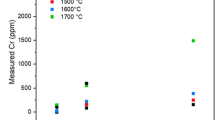Abstract
A trend in the operation of nuclear power reactors is the increase in discharge burnup of the fuel. Intrusion of groundwater in a failed canister of a future deep repository is expected to occur in the presence of hydrogen, produced by the anoxic corrosion of iron and by radiolysis of water. Compelling evidence now exists that hydrogen inhibits oxidative dissolution of irradiated nuclear fuel or alpha doped UO2, however the number of studies involving high burnup fuel are limited. In the experiment PWR UO2 fuel with a burnup of ~75 MWd/kgU was leached in simulated groundwater (10 mM NaCl, 2 mM NaHCO3) at room temperature under 5 MPa of hydrogen. Since the main objective was to investigate the fuel matrix dissolution, a fuel fraction that had previously been leached for over one year was reused. The U-238 and Tc-99 concentration was found to vary in the samples taken over 1100 days of leaching, depending on the degree of centrifugation. The erratic behavior of this autoclave experiment is tentatively attributed to a high surface area, with sub-micrometer sized fuel particles adhering to larger fuel fragments (evidenced by electron microscopy), caused by the fuel milling at the start of the experiment. This likely promoted an increased amount of pre-oxidation of the fuel as well as the potential for reductive precipitation and subsequent release of colloids from the autoclave. As a comparison, initial results from an ongoing autoclave experiment with coarser fuel fragments are also given.
Similar content being viewed by others
References
R. S. Forsyth and L. O. Werme, J. Nucl. Mater. 1902–19 (1992).
D. W. Shoesmith, J. Nucl. Materials, 282, 1–31 (2000).
E. Ekeroth, J. Low, H-U Zwicky, K. Spahiu, MRS Symp. Proc. 1124, 123–128 (2009)
S. Rollin, K. Spahiu and U-B. EklundJ. Nucl. Materials 297, 231–243 (2001)
K. Spahiu, L. Werme and U-B. Eklund, Radiochim. Acta 88507–511 (2000)
K. Spahiu, D. Cui, and M. Lundström, Radiochim. Acta 92, 625–629 (2004).
A. Loida, V. Metz, B. Kienzler, and H. Geckeis, J. Nucl. Mat. 34624–31 (2005)
P. Fors, P. Carbol, S. Van Winkel and K. Spahiu, J. Nucl. Mater. 394, 1–8 (2009).
R. Guillamont et al., Update on the chemical thermodynamics of U, Np, Pu, Am and Tc, OECD NEA, Elsevier 2003.
L. Johnson et al. J. Nucl. Materials 42054–62 (2012)
H-U Zwicky, J. Low, E. Ekeroth, SKB Technical Report TR-11-03 (2011)
O. Roth et al. Final Workshop Proceedings 7th EC FP FIRST-Nuclides 173–180 (2014)
Author information
Authors and Affiliations
Rights and permissions
About this article
Cite this article
Puranen, A., Granfors, M., Ekeroth, E. et al. Lessons learned from leaching of dry milled high burnup UO2 fuel under H2 atmosphere. MRS Advances 1, 4169–4175 (2016). https://doi.org/10.1557/adv.2017.205
Published:
Issue Date:
DOI: https://doi.org/10.1557/adv.2017.205



